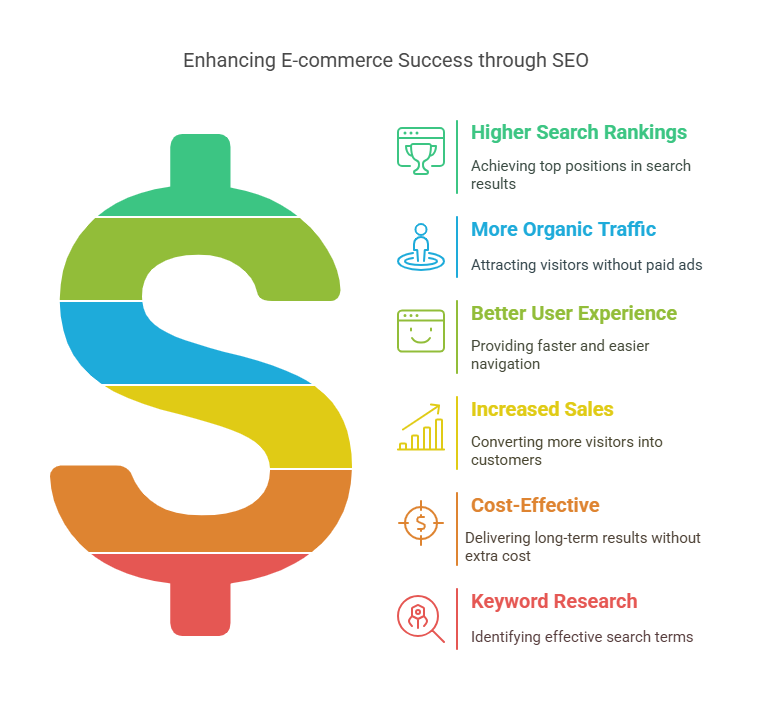Running an online store is exciting, but getting customers to find your website can be challenging. With millions of eCommerce websites competing for attention, standing out requires more than great products. Ecommerce SEO Rankstar is the key to ranking higher on search engines, attracting organic traffic, and increasing sales.
This guide briefly explains everything you need to know about eCommerce SEO. You’ll have actionable strategies to improve your store’s visibility and performance by the end.
E-commerce SEO (Search Engine Optimization) improves an online store’s visibility in search engines like Google. Optimizing website elements like product descriptions, images, site speed, and content increases traffic and conversions.
“SEO is not about gaming the system. It’s about learning how to play by the rules.” – Neil Patel
Benefits of Ecommerce SEO
- Higher Search Rankings: A well-optimized store appears at the top of search results.
- More Organic Traffic: SEO attracts visitors without paid ads.
- Better User Experience: Optimized websites load faster and are easier to navigate.
- Increased Sales: More traffic means more potential customers.
- Cost-Effective: Unlike paid ads, SEO provides long-term results at no extra cost.
Key Components of Ecommerce SEO
1. Keyword Research
Finding the right keywords is the foundation of a successful SEO strategy. Your customers use specific words to search for products, and you need to identify them.
How to Find the Best Keywords
- Use SEO tools like Google Keyword Planner, Ahrefs, or Ubersuggest to help find high-ranking keywords.
- Check Competitor Keywords: Analyze successful competitors’ websites.
- Focus on Long-Tail Keywords: Instead of targeting “shoes,” aim for “best running shoes for flat feet.”
- Use LSI Keywords: Related terms help Google understand your content better.
Example LSI Keywords for “Ecommerce SEO Rankstar”:
- Online store optimization
- Product page SEO
- Increase eCommerce sales
- SEO for Shopify stores

2. On-Page Optimization
On-page SEO improves the content and structure of your site. Key areas to focus on:
Optimize Product Pages
- Use descriptive product titles with keywords.
- Write unique, engaging product descriptions.
- Include high-quality images with keyword-rich alt text.
- Add customer reviews for credibility.
Improve URL Structure
- Keep URLs short and readable.
- Use hyphens instead of underscores.
Optimize Meta Titles and Descriptions
- Meta Title: Should include the main keyword.
- Meta Description: Summarizes the page in 155-160 characters.
Example:
- Meta Title: “Ecommerce SEO Rankstar – Increase Your Store’s Visibility”
- Meta Description: “Learn how to optimize your eCommerce website for higher rankings, more traffic, and increased sales.”
3. Technical SEO
Technical SEO ensures search engines can crawl and index your site efficiently. Important factors:
Site Speed
A slow website drives customers away. Improve speed by:
- Compressing images.
- Using a fast hosting provider.
- Minimizing JavaScript and CSS files.
Mobile-Friendliness
Most online shoppers use mobile devices. Make sure your website is responsive and mobile-friendly.
Secure Website (HTTPS)
Google prioritizes secure websites. Install an SSL certificate to protect customer data.
- 53% of all website traffic comes from organic search. (BrightEdge)
- SEO leads have a 14.6% close rate, compared to 1.7% for outbound marketing. (HubSpot)
- 88% of consumers trust online reviews as much as personal recommendations. (Search Engine Land)
4. Content Marketing for Ecommerce SEO
A blog can boost eCommerce SEO by providing valuable content. Examples of blog topics:
- “How to Choose the Right Sneakers for Running”
- “Best Skincare Products for Dry Skin”
- “A Complete Guide to Choosing the Right Laptop”
Benefits of Blogging
- It helps rank for more keywords.
- Establishes your brand as an authority.
- Encourages backlinks from other websites.
Off-Page SEO Strategies
Off-page SEO refers to actions taken outside your website to improve rankings.
1. Link Building
Quality backlinks improve credibility. Ways to get them:
- Guest Blogging: Write for industry-related blogs.
- Influencer Collaborations: Partner with influencers in your niche.
- Business Directories: List your store on Google My Business and Yelp.
2. Social Media Signals
While social media doesn’t directly impact SEO, it helps increase brand awareness and traffic.
- Share blog posts and product pages.
- Engage with your audience.

Measuring Ecommerce SEO Success
Tracking progress is essential to improve SEO efforts. Use tools like:
- Google Analytics: Monitor traffic and user behaviour.
- Google Search Console: Track keyword rankings and site errors.
- Ahrefs & SEMrush: Analyze backlinks and competitor performance.
Key Metrics to Watch:
- Organic Traffic: How many visitors come from search engines?
- Bounce Rate: Do users leave quickly?
- Conversion Rate: Are visitors making purchases?
- Keyword Rankings: Are you moving up in search results?
Standard Ecommerce SEO Mistakes to Avoid
- Keyword Stuffing: Overloading content with keywords reduces readability.
- Duplicate Content: Copying descriptions from other sites hurts rankings.
- Ignoring Mobile Optimization: Mobile users need a smooth experience.
- Neglecting Image SEO: Unoptimized images slow down site speed.
- Skipping Internal Links: Linking to other pages keeps users engaged longer.
FAQs
1. How long does it take to see results from e-commerce SEO?
SEO takes time. You may see improvements in 3-6 months, depending on competition and effort.
2. Do I need to hire an expert for SEO?
Not necessarily. With the right strategies, you can optimize your store yourself.
3. Is blogging necessary for eCommerce SEO?
Yes. Blogging helps target additional keywords and attracts backlinks.
4. What is the best eCommerce platform for SEO?
Platforms like Shopify, WooCommerce, and Magento offer great SEO features.
5. How do backlinks help in SEO?
Backlinks from reputable sites boost domain authority, improving rankings.
E-commerce SEO Rankstar is essential for online success. Implementing keyword research, on-page SEO, technical improvements, and content marketing can help your store attract more customers and boost sales.
Stay updated with SEO trends, track performance, and continuously improve your strategy. The more effort you put in, the better the results will be.

